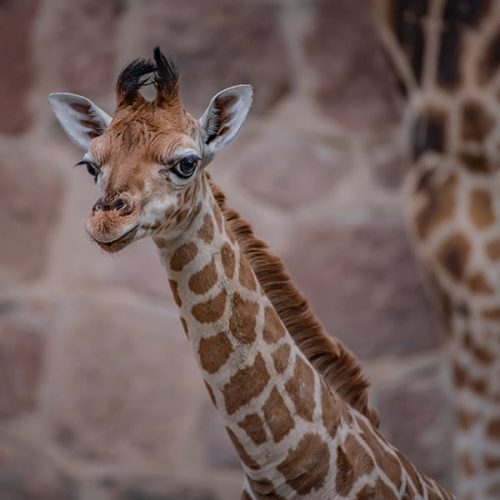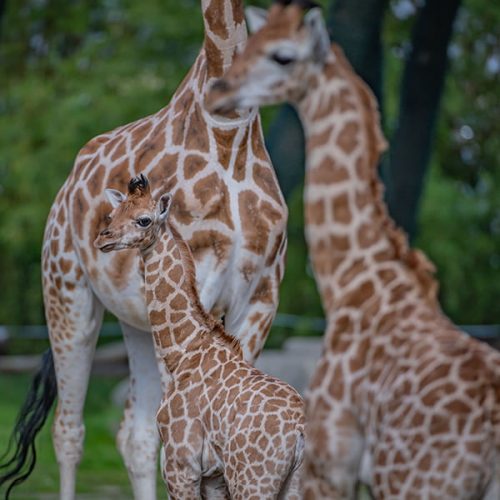A one-week-old giraffe calf, born at Chester Zoo, has ventured outside to play for the first time!

The not-so-little youngster, who already stands at just over 6ft tall and weighs more than 80kg, spent an hour running around and getting know her extended family – after spending a week bonding indoors with her mum, Orla.
Keepers have named the female calf ‘Karamoja’ after the region in Uganda where zoo conservationists are working to protect some of the last remaining populations of wild Rothschild’s giraffes in Kidepo Valley National Park.
Karamoja is the second Rothschild’s giraffe to be born at the zoo in the space of just two months. She came hot on the heels of her eight-week-old brother, Mburo.
Conservationists at the zoo have hailed the duo as vitally important additions to the global breeding programme, which is working to safeguard the future of the species.
PSSSTT
Mike Jordan, Collections Director at the zoo, said:
Having had a succession of boys born here in recent years, it’s wonderful to now have a little girl running around too.
Karamoja, or ‘Mojo’ as the keepers have been calling her for short, has bonded really well with her mum Orla over the past week and so it’s now time for her to be introduced to the rest of the herd. She’s full of energy and will certainly be keeping the herd busy, especially now they have two youngsters to contend with.
The birth of a Rothschild’s giraffe is always reason for huge celebration, particularly given how few they number in the wild. But to have two born in the space of just eight weeks, one male and one female, is a terrific double boost for the breeding programme that’s part of a coordinated effort to prevent their extinction.

Rothschild’s giraffes are one of the world’s most at-risk mammals, with just 2,650 remaining on the planet.
However, recent news from Uganda is giving those fighting for the long-term survival of the species reason to be optimistic. New data reveals that giraffe numbers are slowly increasing in two national parks in the country – including Kidepo Valley, where Chester Zoo and its project partners are working.
PSSSTT
Mike added:
“The team here at Chester regularly heads out to Uganda to lend expertise to the huge, ongoing efforts that are fighting to protect Rothschild’s giraffes in the wild – working alongside our major project partners The Giraffe Conservation Foundation (GCF) and Uganda Wildlife Foundation (UWA). To be part of this success story – where numbers in the wild have increased as a result of the work to track, monitor and protect giraffes in Kidepo – is absolutely incredible.
It’s important though to remember that giraffe populations across Africa remain highly threatened as a result of poaching and habitat loss. They are experiencing a silent extinction in the wild and it cannot continue to go unnoticed, so hopefully our new arrivals will help draw some much needed attention to the efforts needed to protect these gentle giants.”
Rothschild’s giraffe facts:
- Mum Orla is 11 years old (born 17 March 2008).
- Dad Meru is eight years old (born 03/04/2010)
- Rothschild’s giraffes are one of the most endangered of the nine sub-species of giraffe
- They are named after zoologist Lord Walter Rothschild, founder of the National History Museum in Tring, Hertfordshire
- The species is identified by its broader dividing white lines and has no spots beneath the knees
- Once wide-ranging across Kenya, Uganda and Sudan, the Rothschild’s giraffe has been almost totally eliminated from much of its former range and now only survives in a few small, isolated populations in Kenya and Uganda
- Estimates suggest that less than 2,650 Rothschild’s giraffes remain in the wild
- Roughly one-third of the surviving population of Rothschild’s giraffes live in zoos where carefully co-ordinated breeding programmes are creating a safety-net population for the species
- The main threat to the species now is loss of habitat and poaching for meat and hides
- In the past, giraffes were hunted for their tails, which were used as good-luck charms, sewing thread and even fly swats
- Predators to the Rothschild’s giraffe include hyenas, lions, crocodiles and leopards
Find out more about our WONDERFUL zoo and all of the incredible animals, plants and FUN things to do here. Download our app or PDF map to help plan you day and find your way around when you get here.